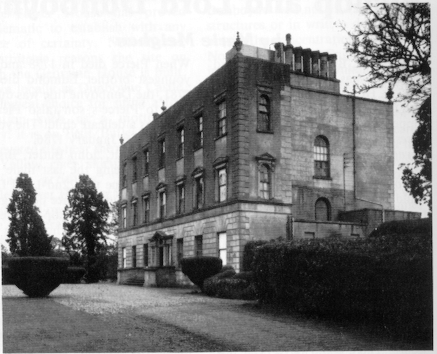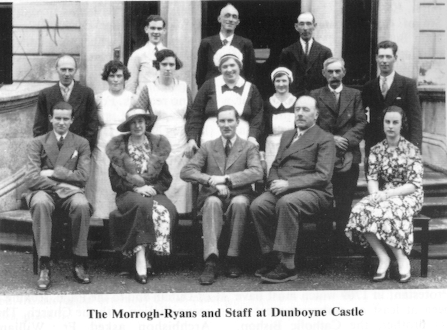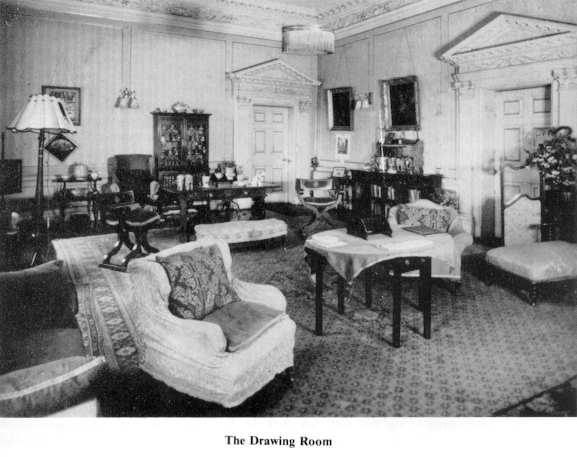|
| |
 
This
imposing house, with its three stories and seven bay windows dates from
the mid-eighteenth century. It was probably built on the site of the Anglo-Norman
motte referred to by the late Fr. John Brady in his continuation of the
History of the Diocese of Meath. It is also probable that a 'dun' or fort
existed there prior to the coming of the Anglo-Normans. The house dates
from two different periods, the front being the later. It is suggested
that the front may have been inspired by Chamber's Charlemont
House in Dublin and was added to in 1768.
The
last of the Butlers to live there was John Butler, Catholic Bishop of
Cork. Lord John caused a sensation by turning Protestant and marrying
in what proved to be a vain hope of producing an heir. It was during the
last years of his life that he lived in the house and it was here that
a child was born but did not survive. Dunboyne Castle was one of three
houses lived in at various times by Lord Dunboyne, all of which eventually
became convents. Before his death, the house was leased by him to Mr.
James Hamilton who is reputed to have fathered 36 children.
After
Lord Dunboyne's death, a lawsuit developed which saw his property divided
between the trustees of Maynooth College and his family, the house passed
to Mary O'Brien Butler, wife of Nicholas Sadleir. The house fell into
disrepair and according to an account in the Ordnance Survey of 1834,
Sadleir set about carrying out extensive repairs and renovations. Nicholas
Sadleir died in 1855 but the family still had connections with the Castle
when it was sold in 1870.
George
Beamish then became owner and he paid £7,250 for it and 121 acres of land.
The property then passed to the Mangan family who in turn leased it to
the Koenig Family, who were German Catholics with large wine and hotel
interests. It was subsequently leased to the Morrogh-Ryan family. John
Morrogh-Ryan was a very famous polo player and he and his wife lived in
the castle until after the second World War. The building and lands then
became the property of a Mr. Garvey who sold it to the Watchman family.
The entire property was then purchased by the North Eastern Health Board
where the Sisters of the Good Shepherd established a home for pregnant
unmarried girls. The sisters remained there until 1991 when the Eastern
Health Board sold the property.
The
house has many features one of which is the stucco plasters on the ceiling
of what was originally the ballroom and which later became the chapel.
The Master bedroom has been likened to the one in Woburn Abbey. It has
a very ornate stucco ceiling. There is also fine plasterwork over the
stairs. There is a suggestion that the plaster work may have been carried
out by the Francini brothers and/or Robert West.
At
the time of writing the building is empty which is a far cry from the
days when it teemed with butlers, housemaids, gardeners, servants and
coachmen. It took forty men a day to mow the lawns of its magnificent
grounds.
The
house now occupied by George and Lou Gilsenan was the front gate lodge
of the castle. Beside the Lodge were large ornamental gates, which were
illuminated at night. These gates were removed and sold to the Medical
Missionaries of Mary in Drogheda.
The
ornate bridge at Castleview is one of the few remaining features of the
demesne. This bridge was on the avenue, which led from the front entrance
opposite the national school and wound its way through what is now Castleview
up to the front door of the house. Generations of Dunboyne people worked
at the Castle. The late Mary Jane Larkin worked there, as did her mother
before her. Jimmy Neill worked as a gardener there as did his father before
him.
The
Morrogh-Ryan family was highly regarded locally and during their tenure
helped and supported many of the families in the Parish. At the same time
they played host to the nobility of the day. Two of the many illustrious
people to stay at the castle were the late Lord Mountbatten and Lord Fingal.
Lord Fingal's visit was a consequence of the rebellion of 1916. He had
been at the Fairyhouse races on that Easter weekend. Rather than risk
returning to his house in Dublin, he stayed at the castle.
Throughout
its life the castle has seen many highs and lows. Tragedies include the
death of the Bishop's child, the death of Oliver Morrogh-Ryan during World
War II, and more recently the unfortunate death of Mrs. Wachman.
The
castle stands today as a monument to all who lived and worked there -all
of whom in their own time and own way became part of the history of the
Parish.
 
|